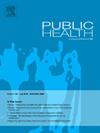中国中老年人群的身体活动与肾功能相关:CHARLS的第一个横断面和纵向证据
IF 3.9
3区 医学
Q1 PUBLIC, ENVIRONMENTAL & OCCUPATIONAL HEALTH
引用次数: 0
摘要
目的慢性肾脏疾病(CKD)已成为中国中老年人常见的健康问题。本研究旨在探讨体育锻炼对中国中老年人肾功能的影响。研究设计:全国队列研究。方法采用2011年中国健康与老龄化纵向研究(CHARLS)的3599名参与者进行横断面研究,估计肾小球滤过率(eGFR)和lt;60 ml/min/1.73 m2作为终点事件。2015年CHARLS的2309名参与者被用于纵向研究,终点事件为eGFR≤60 ml/min/1.73 m2或eGFR降低≥25%。在排除基线eGFR和lt后,纵向研究的2190名参与者;60 ml/min/1.73m2,纳入敏感性分析以重新评估相关性。体力活动强度采用自我报告评估。使用逻辑回归分析体力活动水平与肾功能之间的关系。结果:在横断面分析中,与不运动的参与者相比,参加中度(MPA)或剧烈运动(VPA)超过300分钟/周的参与者发生肾终点事件的可能性显著降低(or = 0.39, 95% CI: 0.30-0.51)。经临床特点和血检结果校正,VPA和MPA >;300 min/周仍是独立的肾功能保护因素。在纵向队列中,300 min/w的VPA和MPA可使肾脏终点事件的风险降低45% (OR = 0.55, 95% CI = 0.38-0.80)。在校正临床特征和血液检查结果后,VPA和MPA >;300min/w仍可分别降低37% (OR = 0.63, 95% CI = 0.43-0.92)和39% (OR = 0.61, 95% CI: 0.42-0.89)的肾终点事件风险。敏感性分析进一步证实了这些发现的稳健性,VPA和MPA >;300分钟/周一直被认为是独立的保护因素。结论体育锻炼可降低肾功能不全的发病风险和延迟发病。这项研究的结果为运动对非慢性肾病人群的肾脏保护作用提供了额外的证据。本文章由计算机程序翻译,如有差异,请以英文原文为准。
Physical activity is associated with renal function in middle-aged and elderly populations in China: first cross-sectional and longitudinal evidence from CHARLS
Objective
Chronic kidney disease (CKD) has become a common health problem among middle-aged and elderly people in China. The aim of this study was to investigate the effects of physical activity on renal function in Chinese middle-aged and elderly people.
Study design
Nationwide cohort study.
Methods
3599 participants in the 2011 China Health and Aging Longitudinal Study (CHARLS) were used in the cross-sectional study, with estimated glomerular filtration rate (eGFR) < 60 ml/min/1.73 m2 as the endpoint event. 2309 participants in the 2015 CHARLS were used in the longitudinal study, with eGFR <60 ml/min/1.73 m2 or ≥25 % decrease in eGFR as the endpoint events. 2190 participants from the longitudinal study, after excluding those with baseline eGFR < 60 ml/min/1.73m2, were included in a sensitivity analysis to reassess the associations. Physical activity intensity was assessed by self-report. Associations between physical activity levels and renal function were analyzed using logistic regression.
Results
In cross-sectional analyses, engaging in moderate (MPA) or vigorousphysical activity (VPA) for more than 300 min/week was associated with a significantly lower likelihood of renal endpoint events compared to physically inactive participants (OR = 0.39, 95 % CI: 0.30–0.51). After correction for clinical characteristics and blood test results, VPA and MPA >300 min/week remained independent protective factors for renal function. In the longitudinal cohort, VPA and MPA >300 min/w reduced the risk of renal endpoint events by 45 % (OR = 0.55, 95 % CI = 0.38–0.80). After correcting for clinical characteristics and blood test results, VPA and MPA >300min/w still reduced the risk of renal endpoint events by 37 % (OR = 0.63, 95 % CI = 0.43–0.92) and 39 % (OR = 0.61, 95 % CI: 0.42–0.89), respectively. Sensitivity analysis further confirmed the robustness of these findings, with VPA and MPA > 300 min/week consistently identified as independent protective factors.
Conclusions
Physical activity is associated with a reduced risk and delayed onset of renal insufficiency. The results of this study provide additional evidence for the renoprotective effects of exercise in non-CKD populations.
求助全文
通过发布文献求助,成功后即可免费获取论文全文。
去求助
来源期刊

Public Health
医学-公共卫生、环境卫生与职业卫生
CiteScore
7.60
自引率
0.00%
发文量
280
审稿时长
37 days
期刊介绍:
Public Health is an international, multidisciplinary peer-reviewed journal. It publishes original papers, reviews and short reports on all aspects of the science, philosophy, and practice of public health.
 求助内容:
求助内容: 应助结果提醒方式:
应助结果提醒方式:


